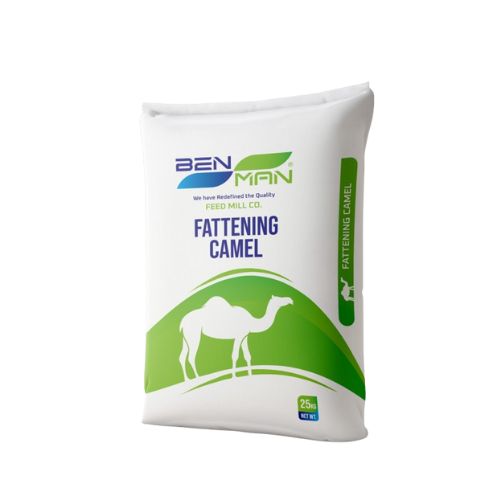Camel Feed – Heavy Livestock
Produced by Avid Zist Fanavaran Nil Company
Avid Zist Fanavaran Nil, leveraging advanced technologies and specialized knowledge in animal, poultry, and aquatic feed production, offers high-quality products tailored to the specific nutritional needs of various animals. The company’s camel feed for heavy livestock is formulated based on the latest scientific research and nutritional principles to enhance the health, performance, and productivity of camels.
The Importance of Proper Nutrition for Camels
Camels (Camelus dromedarius and Camelus bactrianus) play a vital role in meat and milk production in desert and semi-desert regions due to their remarkable resistance to harsh conditions. Proper nutrition is essential to maintain their health, growth, and productivity.
✔ Camels are pseudo-ruminants and lack the omasum.
✔ They can digest low-quality forage and desert vegetation.
✔ Thanks to their ability to recycle nitrogen, they require less costly protein intake.
Standard Feed Ration for Camels
Ration formulation for camels should consider breed, age, weight, and physiological condition. Basic feed components include:
✔ High-quality forages (alfalfa, grass hay, straw)
✔ Nutritious grains (barley, oats, corn)
✔ Affordable fiber sources (wheat straw, bran)
✔ Suitable desert plants
🔹 Note: Bulky forages should not exceed 35% of the total ration to prevent digestive issues.
Nutritional Composition of Camel Feed – Heavy Livestock
| Nutrient | Amount (%) |
|---|---|
| Crude Protein | 10–14 |
| Crude Fiber | 20–28 |
| Crude Fat | 2–5 |
| Ash | 7–11 |
| Moisture | 8–12 |
| Calcium | 0.5–1.2 |
| Phosphorus | 0.3–0.7 |
| Metabolizable Energy (Mcal/kg) | 2.1–2.6 |
🔹 This formulation meets the nutritional needs of camels at various stages of growth and production.
Role of Desert Plants in Camel Nutrition
Camels naturally feed on a wide variety of desert plants and can identify and avoid toxic species. This makes them effective natural grazers, playing a key role in rangeland conservation and sustainable pasture management.
Useful Desert Plants for Camels:
✔ Seidlitzia rosmarinus – A suitable alfalfa alternative in dairy camel diets
✔ Artemisia sieberi – A source of fiber and antioxidants
✔ Tamarix spp. – Rich in essential minerals
✔ Alhagi maurorum – Supports digestive health
Evaluating Forage Replacement in Dairy Camel Diets
Research has shown that replacing alfalfa with desert plants like Seidlitzia in dairy camel diets positively affects milk production and animal health.
📌 Study Highlights:
✔ 18 Sindhi dairy camels were fed diets with varying levels of Seidlitzia over 42 days.
✔ Results: Improved milk yield, digestive health, and overall animal well-being in groups with partial alfalfa replacement.
Nutritional Benefits of Camel Milk
🔹 Camel milk is rich in essential nutrients:
| Nutrient | Camel Milk | Cow Milk |
|---|---|---|
| Vitamin C | 3x higher | Standard |
| Calcium | Higher | Moderate |
| Potassium | High | Moderate |
| Lactose | Lower | Higher |
| Fat | Lower | Higher |
✔ Lower fat content and smaller fat globules make camel milk easier to digest and reduce allergic reactions.
✔ Ideal for lactose-intolerant individuals and beneficial in managing diabetes and digestive disorders.
Camel Feeding Guide Based on Physiological Needs
| Life Stage | Daily Feed Intake (kg/day) |
|---|---|
| Fattening Camels | 7–10 |
| Dairy Camels | 10–15 |
| Pregnant Camels | 9–12 |
| Resting Camels | 6–8 |
📌 Important Notes:
🔹 Feed amounts depend on body condition, environmental conditions, and activity level.
🔹 Continuous access to clean water and mineral supplements is essential for optimal performance.
Summary & Benefits of Heavy Livestock Camel Feed
✅ Scientifically formulated to match the physiological needs of camels
✅ Incorporates natural nutrients and desert plants
✅ Provides essential minerals, vitamins, and proteins
✅ Enhances health, digestion, and milk/meat productivity
✅ Reduces feeding costs through smart forage substitution
📞 For consultation and purchasing camel feed, contact Avid Zist Fanavaran Nil.


Reviews
There are no reviews yet.